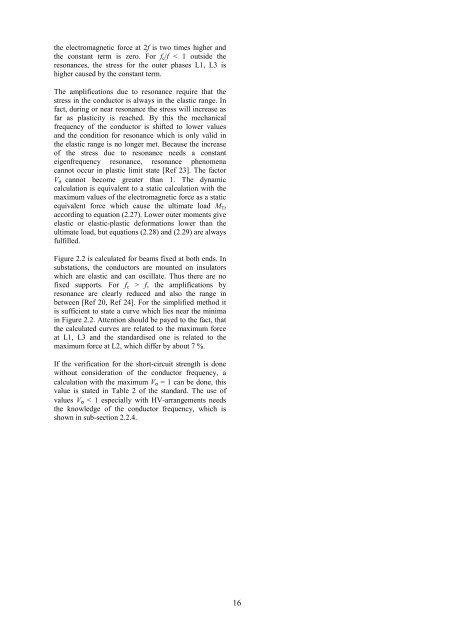The mechanical effects of short-circuit currents in - Montefiore
The mechanical effects of short-circuit currents in - Montefiore
The mechanical effects of short-circuit currents in - Montefiore
Create successful ePaper yourself
Turn your PDF publications into a flip-book with our unique Google optimized e-Paper software.
the electromagnetic force at 2f is two times higher and<br />
the constant term is zero. For fc/f < 1 outside the<br />
resonances, the stress for the outer phases L1, L3 is<br />
higher caused by the constant term.<br />
<strong>The</strong> amplifications due to resonance require that the<br />
stress <strong>in</strong> the conductor is always <strong>in</strong> the elastic range. In<br />
fact, dur<strong>in</strong>g or near resonance the stress will <strong>in</strong>crease as<br />
far as plasticity is reached. By this the <strong>mechanical</strong><br />
frequency <strong>of</strong> the conductor is shifted to lower values<br />
and the condition for resonance which is only valid <strong>in</strong><br />
the elastic range is no longer met. Because the <strong>in</strong>crease<br />
<strong>of</strong> the stress due to resonance needs a constant<br />
eigenfrequency resonance, resonance phenomena<br />
cannot occur <strong>in</strong> plastic limit state [Ref 23]. <strong>The</strong> factor<br />
Vσ cannot become greater than 1. <strong>The</strong> dynamic<br />
calculation is equivalent to a static calculation with the<br />
maximum values <strong>of</strong> the electromagnetic force as a static<br />
equivalent force which cause the ultimate load MTr<br />
accord<strong>in</strong>g to equation (2.27). Lower outer moments give<br />
elastic or elastic-plastic deformations lower than the<br />
ultimate load, but equations (2.28) and (2.29) are always<br />
fulfilled.<br />
Figure 2.2 is calculated for beams fixed at both ends. In<br />
substations, the conductors are mounted on <strong>in</strong>sulators<br />
which are elastic and can oscillate. Thus there are no<br />
fixed supports. For fc > f, the amplifications by<br />
resonance are clearly reduced and also the range <strong>in</strong><br />
between [Ref 20, Ref 24]. For the simplified method it<br />
is sufficient to state a curve which lies near the m<strong>in</strong>ima<br />
<strong>in</strong> Figure 2.2. Attention should be payed to the fact, that<br />
the calculated curves are related to the maximum force<br />
at L1, L3 and the standardised one is related to the<br />
maximum force at L2, which differ by about 7 %.<br />
If the verification for the <strong>short</strong>-<strong>circuit</strong> strength is done<br />
without consideration <strong>of</strong> the conductor frequency, a<br />
calculation with the maximum Vσ = 1 can be done, this<br />
value is stated <strong>in</strong> Table 2 <strong>of</strong> the standard. <strong>The</strong> use <strong>of</strong><br />
values Vσ < 1 especially with HV-arrangements needs<br />
the knowledge <strong>of</strong> the conductor frequency, which is<br />
shown <strong>in</strong> sub-section 2.2.4.<br />
16











